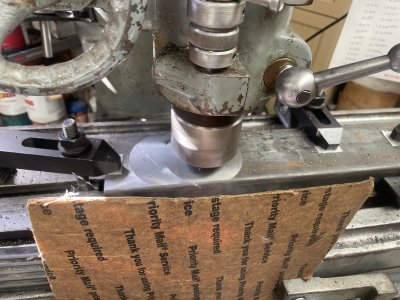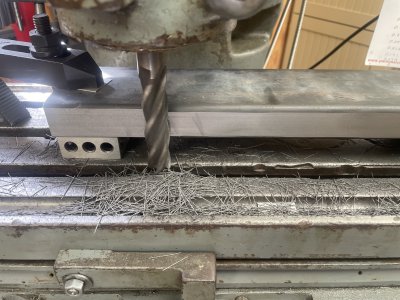I'd like to make a replacement gib for my cold saw. Everyone recommends cast iron. As thin as a gib is, it seems like I'd break the cast iron very easily. Someday when I feel like punishing myself I'm just going to make one on the mill, in steel. Put some oil channels in it and call it good for a 50 year old cold saw. It currently has a plastic one that some previous owner made. It doesn't move as freely as I'd like.compound, magnetic sine and a surface grinder would be in the tool list.
-
Welcome back Guest! Did you know you can mentor other members here at H-M? If not, please check out our Relaunch of Hobby Machinist Mentoring Program!
You are using an out of date browser. It may not display this or other websites correctly.
You should upgrade or use an alternative browser.
You should upgrade or use an alternative browser.
Making a tapered gib
- Thread starter T. J.
- Start date
- Joined
- Jun 7, 2013
- Messages
- 10,086
One can also just shim up the magnetic chuck on the surface grinder on one end. I made a gib for a Bridgeport type mill once for a customer, and did it with my G&E universal shaper, I was able to use the old gib to back up the new one while doing the taper on the top and bottom.It seems to me Kieth Rucker made one for someone.
An interesting job. Pretty complex.
I would think a compound, magnetic sine and a surface grinder would be in the tool list.
- Joined
- Jun 7, 2013
- Messages
- 10,086
I have seen steel used for thin gibs, particularly on parts that don't see a lot of motion.One can also just shim up the magnetic chuck on the surface grinder on one end. I made a gib for a Bridgeport type mill once for a customer, and did it with my G&E universal shaper, I was able to use the old gib to back up the new one while doing the taper on the top and bottom.
- Joined
- Mar 26, 2018
- Messages
- 8,407
A shaper would be perfect for this application.One can also just shim up the magnetic chuck on the surface grinder on one end. I made a gib for a Bridgeport type mill once for a customer, and did it with my G&E universal shaper, I was able to use the old gib to back up the new one while doing the taper on the top and bottom.
Then to the surface plate and scraper table.
- Joined
- Feb 1, 2018
- Messages
- 1,868
I told him that and I just didn't want to repeat it here and type it again. He maybe smart to have John York make it for him as John is a master machinist and engineer.
- Joined
- Feb 1, 2018
- Messages
- 1,868
You told me you were going to start making it last weekend? How is it going. Once you mill it, you will need to scrape both sides flat to at least 5 PPI before fitting it.
- Joined
- Oct 31, 2015
- Messages
- 467
Welll, I got started and then got called away for a work emergency (that’s about normal for me). But here are some pics the progress so far.
To catch everyone here up, Richard has been giving me some advise over on his FB group. He suggested I use the technique illustrated in this thread on PM: https://www.practicalmachinist.com/...ag-12-restoration-progress-237940/index3.html
The author formed the mating sides (the ‘flat’ side and the ‘tapered’ side) by side milling. The reason Richard suggested this method is that the tables on old mills tend to sag at the ends of their travel. (My mill definitely fits into the “old, worn out” category!)
With a long gib such as mine, this would be a problem if I was to form the mating sides by end milling.
The material I am using is a bar of extruded gray iron about 1-1/4” thick and 3-1/4” wide. I cut it to 15” long, which is how long I decided to make the gib. I then clamped it to the table and cleaned up one wide face with a fly cutter.
Out of curiosity, after milling I put the bar on my surface plate. It hinges exactly in the middle and I’m able to insert a 0.002” feeler gage under both ends. That would definitely be a problem if I was forming the taper by end milling!
Next, I turned it over and clamped it to some 123 blocks to clean up one narrow side.

That’s when I had to quit. My shop time is going to be hit or miss for the next week, but I’ll post updates on my progress when I can.
To catch everyone here up, Richard has been giving me some advise over on his FB group. He suggested I use the technique illustrated in this thread on PM: https://www.practicalmachinist.com/...ag-12-restoration-progress-237940/index3.html
The author formed the mating sides (the ‘flat’ side and the ‘tapered’ side) by side milling. The reason Richard suggested this method is that the tables on old mills tend to sag at the ends of their travel. (My mill definitely fits into the “old, worn out” category!)
With a long gib such as mine, this would be a problem if I was to form the mating sides by end milling.
The material I am using is a bar of extruded gray iron about 1-1/4” thick and 3-1/4” wide. I cut it to 15” long, which is how long I decided to make the gib. I then clamped it to the table and cleaned up one wide face with a fly cutter.

Out of curiosity, after milling I put the bar on my surface plate. It hinges exactly in the middle and I’m able to insert a 0.002” feeler gage under both ends. That would definitely be a problem if I was forming the taper by end milling!
Next, I turned it over and clamped it to some 123 blocks to clean up one narrow side.

That’s when I had to quit. My shop time is going to be hit or miss for the next week, but I’ll post updates on my progress when I can.
- Joined
- Mar 26, 2018
- Messages
- 8,407
Challenge.....He maybe smart to have John York make it for him as John is a master machinist and engineer.
- Joined
- Feb 1, 2018
- Messages
- 1,868
TJ, it looks good and .002 is acceptable on and old mill. You can scrape that off. I can't wait for some more progress. Thanks for sharing.
Rich
Rich
- Joined
- Mar 26, 2018
- Messages
- 8,407
.002" to scrape reminded me of an aha moment at Richard's class.TJ, it looks good and .002 is acceptable on and old mill. You can scrape that off. I can't wait for some more progress. Thanks for sharing.
Rich
I was scraping a large angle plate, chasing my tail. It finally occurred to me, you have to scrape to the point where the lows become the highs.
In Richard's handout, (I don't have it with me) there is terminology for this.
If you just scrape the high points, deburr, clean, blue, hinge then rub to find you get to do it all over again and never get any closer to completion.
I learned that lesson!
Did I get it right Rich? I haven't scraped since the class. I need to change this.

